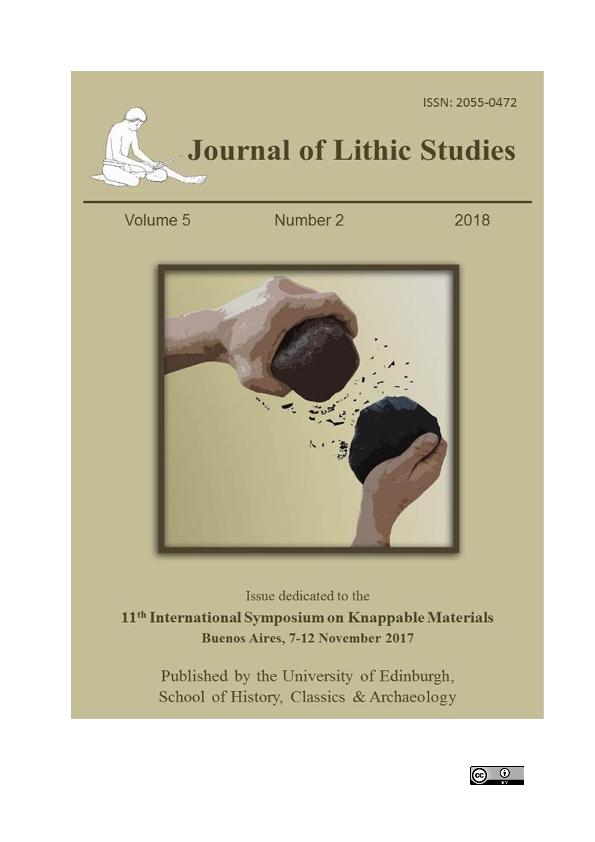Mostrar el registro sencillo del ítem
dc.contributor.author
Banegas, Anahi

dc.contributor.author
Bonomo, Mariano

dc.contributor.author
Gomez Otero, Julieta

dc.date.available
2020-03-18T14:13:56Z
dc.date.issued
2018-12
dc.identifier.citation
Banegas, Anahi; Bonomo, Mariano; Gomez Otero, Julieta; Bipolar flaking as a component of a supraregional lithic resource base: A comparative study of cores from the Pampean and Northcentral Patagonian Atlantic coasts (Argentina); University of Edinburgh. School of History, Classics and Archaeology; Journal of Lithic Studies; 5; 2; 12-2018; 1-21
dc.identifier.issn
2055-0472
dc.identifier.uri
http://hdl.handle.net/11336/99981
dc.description.abstract
Several authors argue that bipolar technology is an expeditious and versatile strategy, efficient for the reduction of small nodules. However, few studies analyze the use of bipolar reduction in relation to the lithic environmental supply. At the Pampean and Patagonian maritime coast, the technique has been widely recorded and seems to be conspicuous in indigenous populations that occupied coastal areas. With the aim of assessing and comparing the application of bipolar reduction, 196 nuclei recovered from sites of diverse chronologies in the Pampean and northcentral Patagonic coasts were analyzed. The use of the bipolar technique was observed in relation to the lithic environmental structure, the size of nodules and their raw material. The results revealed high frequencies of bipolar nuclei at the Pampean coast (87%) and moderate frequencies at the northcentral Patagonic coast (39%). It was determined that the variables that influenced the application of bipolar techniques the most were the small size of the nodules and their rounded shape, generally thick, and without flat surfaces. As for raw material quality, the technique was applied on good to medium quality rocks at the Pampean coast, while in the northcentral coast it was exclusively applied on pebbles and cobbles of superior qualities (very good to excellent). The differences observed are most likely linked with technological choices made by different coastal populations to make the best use of widely available local rocks.
dc.format
application/pdf
dc.language.iso
eng
dc.publisher
University of Edinburgh. School of History, Classics and Archaeology
dc.rights
info:eu-repo/semantics/openAccess
dc.rights.uri
https://creativecommons.org/licenses/by/2.5/ar/
dc.subject
Lithic technology
dc.subject
Pampean coast
dc.subject
Patagonian coast
dc.subject
Holocene
dc.subject.classification
Arqueología

dc.subject.classification
Historia y Arqueología

dc.subject.classification
HUMANIDADES

dc.title
Bipolar flaking as a component of a supraregional lithic resource base: A comparative study of cores from the Pampean and Northcentral Patagonian Atlantic coasts (Argentina)
dc.type
info:eu-repo/semantics/article
dc.type
info:ar-repo/semantics/artículo
dc.type
info:eu-repo/semantics/publishedVersion
dc.date.updated
2020-02-20T16:38:24Z
dc.journal.volume
5
dc.journal.number
2
dc.journal.pagination
1-21
dc.journal.pais
Reino Unido

dc.journal.ciudad
Edinburgh
dc.description.fil
Fil: Banegas, Anahi. Consejo Nacional de Investigaciones Científicas y Técnicas; Argentina
dc.description.fil
Fil: Bonomo, Mariano. Consejo Nacional de Investigaciones Científicas y Técnicas; Argentina
dc.description.fil
Fil: Gomez Otero, Julieta. Consejo Nacional de Investigaciones Científicas y Técnicas; Argentina
dc.journal.title
Journal of Lithic Studies
dc.relation.alternativeid
info:eu-repo/semantics/altIdentifier/url/http://journals.ed.ac.uk/lithicstudies/article/view/2832
dc.relation.alternativeid
info:eu-repo/semantics/altIdentifier/doi/https://dx.doi.org/10.2218/jls.2832
Archivos asociados
